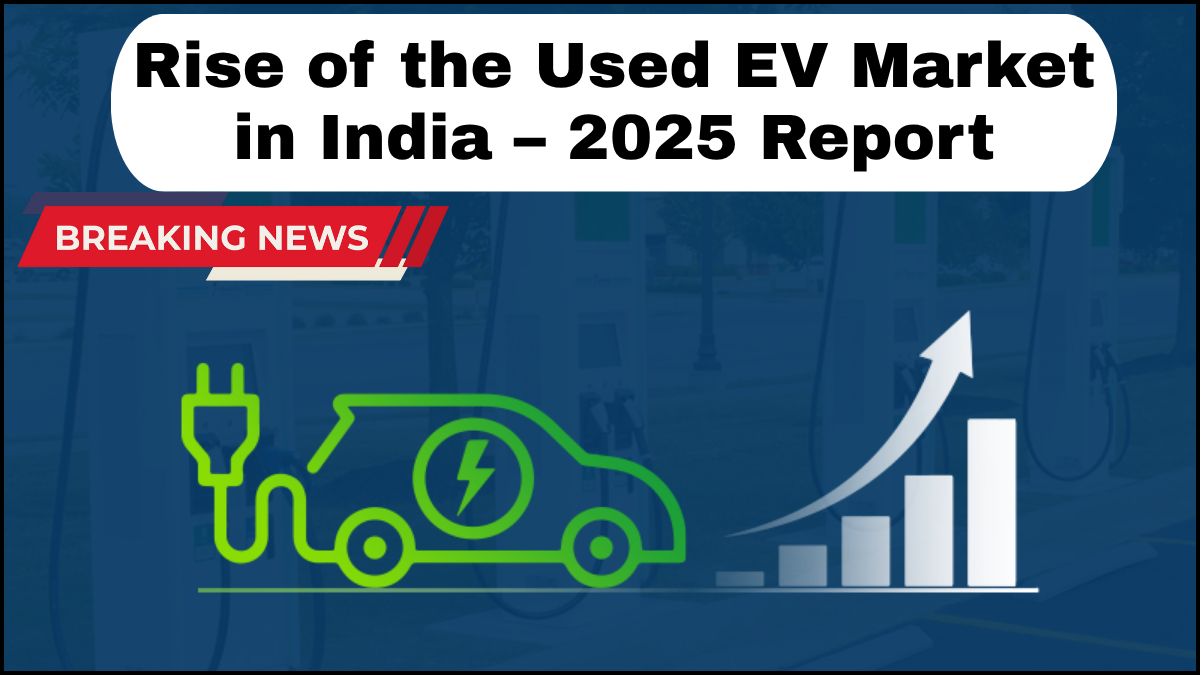India’s electric vehicle (EV) revolution is no longer limited to new car sales. In 2025, a significant shift is unfolding: the used EV market is gaining traction at a pace no one predicted just a few years ago. Driven by rising affordability, growing consumer awareness, and stronger charging infrastructure, the second-hand electric vehicle space is emerging as a viable and attractive option for Indian buyers.

The Shift Towards Sustainability and Affordability
EV adoption in India initially faced challenges around high upfront costs and limited infrastructure. However, as the government rolled out aggressive subsidies and automakers expanded their EV portfolios, sales picked up. Now, this momentum is spilling over into the second-hand electric vehicle segment.
The main driver? Price sensitivity. A new EV, though efficient in the long run, still poses a steep entry cost for most middle-income households. A used electric vehicle, on the other hand, offers access to clean technology without the premium price tag. According to recent market data, the price of used EVs can be 30-50% lower than new counterparts, depending on the make, model, and battery health.
Technology Improvements Driving Confidence
Battery degradation was once the biggest fear for potential used EV buyers. In 2025, that’s no longer the case. Battery technology has significantly advanced, with most EVs now designed to retain up to 80% of their original capacity even after 6-7 years.
Moreover, diagnostics tools have become smarter and more accessible. Buyers can now assess a vehicle’s battery health, range history, and usage patterns before purchase. These advancements have drastically reduced the perceived risk of investing in a second-hand electric vehicle.
Organized Marketplaces Are Professionalizing the Space
Earlier, used EV transactions in India happened informally, with limited buyer protections. That’s changing fast. Startups and established platforms are now curating verified listings, offering warranties on used EVs, and even providing financing options. This increased structure has fueled used EV market growth in tier-1 and tier-2 cities alike.
Companies like Spinny, CarDekho, and OLX Autos have expanded their EV verticals, ensuring every used EV undergoes multi-point inspection, battery diagnostics, and vehicle history verification. These steps are vital for building trust and scalability in a previously unorganized sector.
Government Incentives and Policy Support
Government policies are not just promoting new EV purchases—they’re also creating ripple effects in the resale market. The FAME II scheme indirectly boosts the used EV market growth by increasing the volume of new EVs, which eventually feed the second-hand ecosystem.
Some state governments have also proposed registration fee waivers and road tax exemptions for second-hand electric vehicles. While these benefits vary by region, they further sweeten the deal for buyers considering a pre-owned EV.
Urban Mobility and Fleet Influence
Urban delivery fleets, ride-sharing platforms, and logistics companies have been early adopters of EVs. As these commercial fleets cycle out older vehicles every 3–4 years, they create a consistent pipeline of well-maintained used EVs. These vehicles, often serviced regularly and equipped with decent range, become ideal candidates for resale.
Companies like BluSmart and Amazon’s delivery fleet partners have already begun offloading older EVs into the used market. This trend is expected to accelerate, boosting supply and adding to the depth and diversity of offerings in the second-hand electric vehicle market.
Challenges That Remain
Despite positive trends, the sector faces hurdles. Standardizing battery evaluation, ensuring transparency in ownership transfers, and providing extended warranties are still maturing. There’s also a need for wider charging infrastructure in smaller towns to support used EV market growth across non-metro regions.
Moreover, resale values for some models remain inconsistent due to limited historical data and a lack of standardized pricing benchmarks. These gaps, if addressed, can unlock massive value in the long term.
Future Outlook
By the end of 2025, experts predict that used EVs could account for 8-10% of India’s total second-hand vehicle transactions. As supply scales up and awareness spreads, the used EV sector is poised to become a permanent fixture in India’s automotive landscape.
Auto manufacturers may even join the loop more actively, offering certified pre-owned EV programs, buyback guarantees, and upgrade incentives for second-hand owners. This integration could make the used EV buying journey as seamless as new car ownership today.
FAQs
Q1. Is it safe to buy a used EV in India?
Yes, if purchased from a reliable platform or dealer. Many now offer certified vehicles with battery health reports and warranties, reducing risks significantly.
Q2. How much cheaper are used EVs compared to new ones?
Used EVs can be 30–50% cheaper depending on the age, brand, and battery condition.
Q3. What should I check before buying a second-hand electric vehicle?
Check the battery health, charging history, service records, warranty status, and software updates. A professional inspection is highly recommended.
Q4. Are loans available for used EVs in India?
Yes, several banks and NBFCs now offer financing options specifically for used EVs, often with lower interest rates for green vehicles.
Q5. Will a used EV have enough range for daily use?
Most used EVs from reputable models offer sufficient range (100–300 km) for daily commuting. Battery condition is key, so always verify it through diagnostics.
click here to learn more
